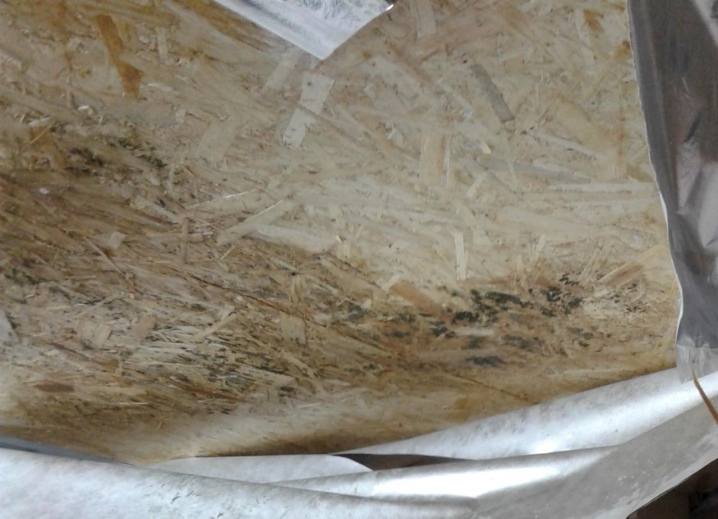How to determine the front side of the OSB board?

The need to find out how to determine the front side of OSB-plates arises for everyone who is independently engaged in the construction or repair of their own house. It is very important to resolve this issue, since errors in fixing materials will lead to the fact that during operation they will be more susceptible to damage. A detailed overview of the markings and other markings applied to the surface will help to find out which side to fasten OSB to the outside, to lay sheets on the floor.

Studying the inscriptions on the stove
Few people know that OSB materials have a so-called seamy side, which differs from the front visually and in marking. You can understand which of them is outdoor by paying attention to the most informative moments. The easiest way is to determine the front side of the OSB visually according to the signs listed below.
-
Chip size. It is as large as possible, significantly larger than the one that is inside out.
-
Shine. A light gloss marks the front side, the back is much dimmer.
-
Lack of roughness. The outer surface is practically devoid of them.
In the case of a laminated variety of OSB, the decorative coating is usually only on one side. She is the front. The tongue-and-groove slabs are also fairly easy to orientate.


It is enough to determine exactly how the lock connection should be located.
As far as labeling is concerned, there is no single standard. Foreign manufacturers most often designate the seamy side with the mark This side down. In fact, the inscription rather determines the orientation of the material during installation. The marked side should be on the bottom.

Many people are concerned about the question of whether to keep the marking coating. A smooth coating, by which the front part of the OSB-board is distinguished, is also on its seamy part, but to a lesser extent. This is a paraffin wax that is applied to surfaces in production so that the material can easily survive transportation and storage. After installation of panels, it significantly reduces their adhesion capacity, complicates the subsequent finishing process.


To improve adhesion to paints, varnishes, adhesives, the paraffin layer is completely removed and sanded. Instead, a special primer is applied, which also has protective characteristics. In this case, the seamy side of the coating can be left with a paraffin spray.

Which side to attach to the wall?
With vertical installation of OSB boards, one also has to solve the problem of material orientation. Before screwing it face-down to the street or deploying it to the wall, you need to understand all the manufacturer's recommendations. Inside living quarters, this moment does not play a special role, since there is no risk of contact with a humid environment.


Different rules apply in the kitchen and bathroom. The smooth and shiny front side should be turned inward here, protecting the slab from delamination, decay, and wetting.
However, additional protection measures will not be superfluous either. It is best if the OSB surface is primed and then covered with a tile finish or glass backsplash.
When sheathing the outer walls of a house or other structure, you also have to follow a number of recommendations. Let's list them.
-
Plates without tongue-and-groove joints can be positioned both vertically and horizontally.
-
The smooth surface is directed towards the street.In this case, drops of water will not linger on it, and the material itself will be protected from the effects of atmospheric factors.
-
The laminated or other decorative coating material is guided with the finished side onto the façade.



Errors in fixing OSB boards lead to the fact that the material quickly deteriorates. When removing the cladding from such a base, after 1-2 years, you can see black spots and stripes, indicating the development of rot and mold. In addition, the lack of protection against moisture can lead to swelling of the material, a change in its geometric parameters. The slab can begin to crumble as it picks up moisture.

How to lay the sheet on the floor and ceiling?
When laying OSB sheets horizontally, manufacturers recommend laying them exactly with the smooth side down. This is important for the creation of roofing, ceiling structures. The non-slip outer cover helps solve the problem of installers moving across the surface of the formed deck. In addition, it is more susceptible to the application of protective, decorative paints and varnishes, which greatly facilitates subsequent processing.
If you need to install a floor covering, the recommendations will be different.

Since the material is subjected to intense mechanical stress, abrasion, the smooth front side, covered with a special impregnation, is placed at the top, and a rough coating remains inside. This rule applies to both finishing and rough floors.
Choosing the right side for laying is very important in this case. If moisture gets in, the smooth coating will not absorb it, and will avoid swelling of the parquet or damage to the laminate, linoleum laid on top. Possible sources of dampness in the basement should also be taken into account if the slabs are laid on the floor. In this case, the lower side will also need to be protected from moisture by applying special impregnations.














The comment was sent successfully.